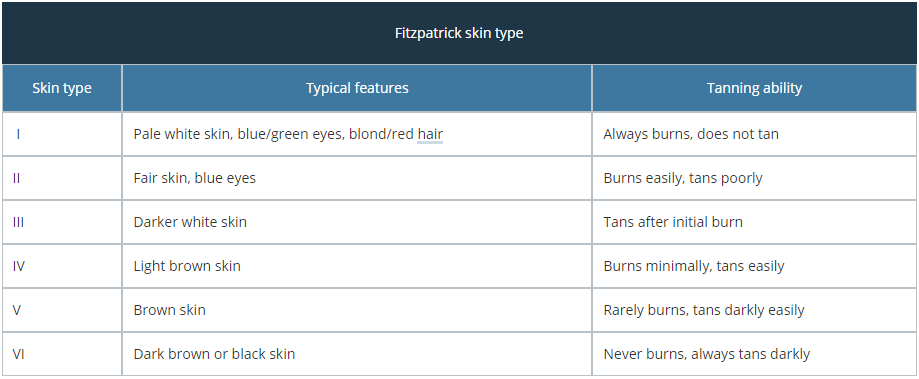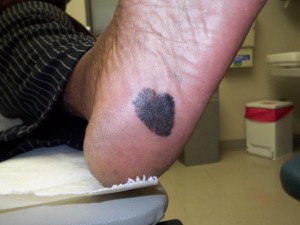Sun-Safety for Skin of Color

Written by Liz Orton, Iowa Cancer Consortium
Dr. Nkanyezi Ferguson is a Clinical Associate Professor of Dermatology at University of Iowa Health Care (UIHC). She has led the Ethnic Skin Care Clinic since 2016, and is the Director of Diversity, Equity, and Inclusion for Graduate Medical Education (GME).
Last December, Dr. Ferguson authored an editorial for JAMA Dermatology that looked at the validity and gaps of current research regarding UV exposure as a risk factor or melanoma in skin of color.
We sat down with her (on Zoom) to learn more about the disparities that exist and her recommendations regarding sun-safety for skin of color.
Defining “Skin of Color”
Before we get started, let’s define “skin of color,” since it might not be a phrase that is familiar outside of the dermatology community. Dermatologists use something called the Fitzpatrick skin types (FSTs) to classify skin based on its reaction to UV exposure and susceptibility to sunburn or tan. Here is a table that defines the FSTs:
So what FSTs are considered to be “skin of color”? One of Dr. Ferguson’s criticisms in her editorial is that there are varied definitions that are subjective and inconsistently applied, but it is commonly understood that skin types IV, V, and VI are “skin of color.” It is important to note, having skin of color does not equal being a person of color, and vice versa. “Skin of color” is a dermatologic term that describes physical attributes of the skin, whereas “people of color” is a societal term that encompasses a variety of racial and ethnic identities.
In this conversation, “skin of color” will be used when talking about science, and “people of color” will be used when discussing health disparities towards Black, Indigenous, and People of Color (BIPOC) that stem from societal racism.
Awareness & Education
Although skin cancer is less common in skin of color, Dr. Ferguson emphasized that it does occur. Furthermore, research shows that skin cancer is diagnosed at a later stage and has a higher mortality rate for people of color. (Use this interactive tool from the CDC to view the latest statistics for melanomas of the skin by race and ethnicity.)
One reason for the disparity in later diagnosis is likely because of gaps in knowledge of clinicians and patients about what signs of skin cancer look like in skin of color. Most photographs in dermatology textbooks are of light skin and Dr. Ferguson said clinicians do not learn the “nuanced differences” of how skin cancers may appear in skin of color. Language like “red, peeling sunburn” is not accurate for all skin types, and redness (erythema) presents differently on skin of color. Finally, patient education materials for skin cancer prevention in skin of color are rare. Professional dermatology associations such as the American Academy of Dermatology Association (where Dr. Ferguson chairs the committee on diversity initiatives) and the Skin of Color Society are working to change these gaps in education and awareness.
Dr. Ferguson said that melanoma in skin of color often occurs in sun-protected areas such as the palms, nailbeds, soles, and mouth. Risk factors for skin cancer in skin of color include depressed immune system, chronic scarring, burns, and skin diseases that lead to scars. The ABCDE’s of melanoma apply to skin of color (Asymmetry, Border, Color, Diameter, and Evolving), and Dr. Ferguson said that patients and physicians should especially look for marks that are multi-colored and/or change appearance over time (Evolving). Skin cancers may also present with more pigment in skin of color.
Prevention & Research
Dr. Ferguson reiterated to us what she wrote in her JAMA editorial: Although more research needs to be done (in many areas), it is still very important that individuals with skin of color practice sun-safety measures like wearing sunscreen and avoiding direct sun exposure during peak hours (10am-4pm). Apart from skin cancer prevention, sun protection also reduces premature aging of the skin from sun damage (photoaging) and UV-related dyspigmentation/discoloration in skin of color.
Sunscreen with an SPF of 30 or more should be applied regularly, as directed. Zinc oxide and titanium dioxide sunscreens work by literally blocking the sun and can leave a white film on the skin – for this reason, Dr. Ferguson recommends looking for micronized/microfine mineral-based UV filters and/or a tinted sunscreen for skin of color. These sunscreens can be found at drugstores or ordered online.
Some areas that Dr. Ferguson identified as needing further research for skin of color include:
- Risk factors and causes of melanoma in sun-protected areas.
- A valid, consistent, and objective measure of FSTs in research.
- How to “integrate a phased approach that includes detecting, understanding, and reducing disparities” rather than merely observing that the disparities exist.
Lastly, Dr. Ferguson expressed the ongoing need for more diversity in research participant pools. In her editorial, she stated that people of color may be missing from research studies due to “mistrust, lack of access, [and] lack of cultural competence in research design.”
Get Involved
We are so grateful that Dr. Ferguson took the time to answer our questions and for all the work she does in this field. If you would like to get involved in reducing health disparities within cancer control, please email [email protected] to learn more about joining our Health Equity Workgroup. If you’re interested in becoming an Iowa Cancer Consortium member, you can learn more about membership opportunities here.
Additional Resources
- American Academy of Dermatology Association – Skin Cancer in People of Color
- Ethnic Skin Care Clinic at UIHC
- JAMA Dermatology – Challenges and Controversy in Determining UV Exposure as a Risk Factor for Cutaneous Melanoma in Skin of Color
- NPR – Ask Code Switch: Will Your Melanin Protect You From The Sun? (Podcast story starts at 19:45, 7-min listen)
- Melanoma Research Foundation – Skin of Color & Melanoma
- Skin of Color Society – Sun Protection for Skin of Color


